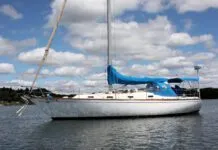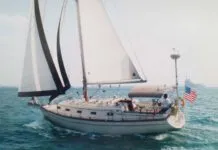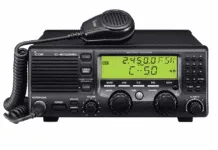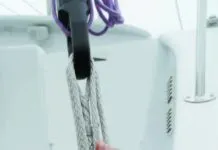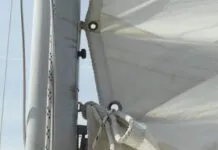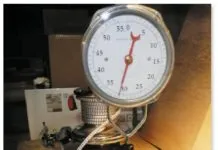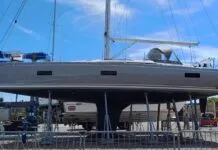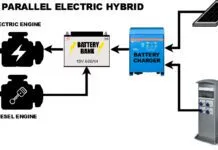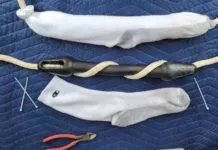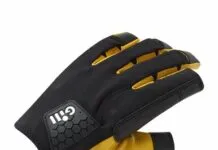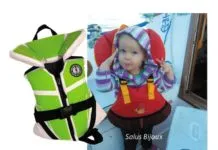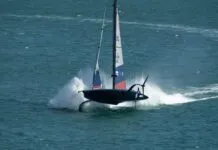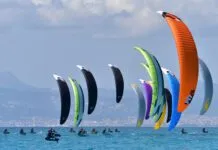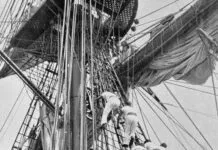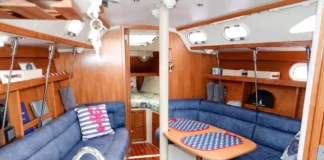Like some form of electro-mechanical Darwinism, GPS chartplotters continue to evolve into many subsets, each filling a potential niche. There are more than a dozen companies vying for your electronics dollar, with a wide range between high to low. What are the reasons for big price differences? Are they justified? Some of the big cost drivers are very large, high-resolution screens, color displays, expanded features, and networking capabilities. How much do you have to spend to get a good unit, do you need color and are there any great values to be found?
Because of the variety, we decided to break GPS chartplotters down into gray scale and color groupings. In this report are the cost-effective gray scale models, most of which are available for under $1,000 at discount.
GPS chartplotters combine the position-finding capability of a GPS unit with the display of that position information on scaleable electronic charts. These electronic charts may be derived from built-in data as well as with updateable slip-in electronic cartridges that greatly increase detail. Other units display maps derived from a CD ROM data disk by temporarily connecting a PC to the chartplotter. Some plotter units have a GPS built in, others require external GPS input.
There are several issues endemic to all GPS units. The first is accuracy. Basic GPS accuracy is capable of an error radius of 15 meters, but because the government has elected to intentionally degrade the GPS signal for security concerns (known as selective availability-SA) accuracy is only capable of a 100-meter radius or better 95% of the time. In other words, your indicated GPS position can be as much as 100 meters off from your actual position. The government has stated that SA will be turned off possibly as early as 2003, but no later than 2006. If greater accuracy is desired now and in the future regardless of SA, differential GPS (DGPS) is available either as an add-on box or extra electronics inside the basic unit. Differential GPS uses ground stations to cancel out SA and increase accuracy to 2-5 meters within range of ground stations that cover much of the major waterways and coastline of the US and more than 22 other countries.
Y2K seems to pervade everything in our society, and unfortunately GPS is no exception. There is also another date of concern. Its known as EOW, which will occur August 22, 1999. On this date the week number transmitted in the satellite navigation message will change from 1023 to zero. Most companies current products will operate properly during these events, but older products may experience some glitches. If you have internet access, check your companys web site for the latest status of their products. They are all in the process of providing and updating Y2K disclosure information.
The last issue is color vs. gray scale displays. Dont automatically assume color is for you. Most of the manufacturers who produce color displays recommend that they not be used outside in bright sunlight, where the gray scale display still has the best contrast ratios and viewing angles.
Map Cartridges
When using map cartridges keep in mind that as seductive as these electronic wonders are, they are not substitutes for having paper charts on hand. Also remember that map cartridges are not guaranteed to be absolutely perfect copies of paper charts and are not approved as a sole means of navigation.
Because a large electronic memory is required to digitize details of a paper chart and the data needs updating, tiny, plug-in reprogrammable data modules have been developed. There are two primary competing companies in this arena: Navionics and C-MAP. Both companies use vector chart technology for the cartridges and chartplotters in this review. Vector technology is much more memory efficient than raster technology and allows for chart details to be shown incrementally (partially or not at all), based on mathematical formulas. Raster charts, on the other hand, are literally digitized paper charts. They are exact duplicates of paper charts, but are memory intensive and are therefore better for very large screens with huge memory capabilities.
Chartplotters use a specific type of cartridge, such as C-MAP NT and are not interchangeable with other C-MAP formats or cartridge brands.
Garmin, one of the biggest GPS makers, has chosen to use Navionics technology in a proprietary format known as G Charts. G Charts and Navionics charts are available both as inland (continental US) and offshore versions (worldwide), with the data emphasis and scale being different in each category. Offshore versions also have several subsets available for a given coverage area. For example, there are versions called extra detailed, detailed, coastal, fishing, and general coverage. Specific descriptions of each type are available from Navionics or Garmin.
C-Map also has inland charts of the continental US. They have also divided up their worldwide offshore chart types for a given area, called Passage Cards, Fishing Cards, Cruising Cards, etc.
The idea is to reduce the number of chart cartridges required for a given purpose to a manageable number (and expense). For example, someone cruising from Virginia to Florida could use a cruising cartridge rather than several more detailed cartridges. Prices vary from $99 to $349, depending on the amount of data.
Cartridges from both companies are periodically updated to keep up with notices to mariners or to correct errors, and both have updates available at reduced rates for owners.
The cartridges generally provide less and less detail as you depart from the prime coverage area. Up to 200 charts may be on one cartridge.
How We Tested
We established baseline accuracy at a fixed position with an unobstructed view of the sky for all the units. This was followed by stationary, partial sky views, and lastly while moving along a section of the Chesapeake Bay full of shoreline trees, rising terrain, numerous boat masts and buildings that might cause multipath reception errors. We looked at the displays inside and outside as well as at night to see how well the backlighting worked.
All the units tested have from 8 to 12 channels, which seemed to do the trick for quick satellite acquisition and great resistance to interference or loss of lock under adverse reception conditions. Most units have substantial (but variable) feature sets, large memories and variable screen sizes and resolution. All have configurable position and map pages, as well as movable cursor controls that allow route making and real time navigating with relative ease. Built-in global maps (mostly outlines) allow basic map orientation without supplemental, add-in map data, but at a much smaller scale.
The real competition among these units is not in basic GPS performance, but rather in the way they operate, and how effectively they display extremely detailed chart data, which without filtering capability would overwhelm the screen. Detailed port data is also now available in the latest cartridges. Extra navigation options and external system interface features also play a role, as well as screen size and resolution.
Group Considerations
The manufacturers have chosen different means to accomplish essentially the same thing. This provides choice for the user. The paper manuals and simulator modes were definitely helpful, as no unit was totally intuitive.
One feature we particularly liked was soft keys. These are context-sensitive keys whose function changes depending on the mode you are in, thus gaining the effect of having more dedicated keys (and easier operational understanding). Magellan, Standard and Raytheon employ this methodology. Simrad goes one step further with pull-down menus and a Windows-like interface. Others use the context-sensitive menu system, which also works-its really a matter of personal choice.
Garmin GPS Map 230
The Garmin GPS Map 230 ($1,390/$850) is a stand-alone GPS with a large rectangular display and built-in world map that zooms from 4,096 miles down to 64 miles (32 in US). By adding optional map cartridges called G Charts (both inland or offshore are available), you can zoom down to 1/8 mile with offshore cartridges.
If you have ever used any other Garmin receiver, you will be comfortable with the 230. Like so many other Garmin GPS units we have tested, it has an almost overwhelming array of customization options. Dedicated keys and extensive menus make this easier. As long as you use the well-illustrated and written manual and keep it handy you will be rewarded with a unit which significantly exceeds most of the other test units in user customizability.
One outstanding feature, characteristic of many Garmin GPS units, is called TracBack. This is an automatic waypoint assignment system that lays down up to 30 waypoints automatically while underway during significant direction changes. If your trip exceeds the memory, the unit uses algorithms to best reconstruct your track path or erases the oldest track points at your option.
Other notable features include instant availability of the nine nearest waypoints from present position.
There is also a provision for an external alarm so you don’t need to be near the GPS to hear it.
Bottom Line: The larger screen helps make up for lower resolution than the other units. We like the TracBack, and the nine independently configurable proximity alarms make it a particularly wise choice for hazardous waters. All in all, this unit has the best combination of safety, emergency and user configuration capability under $1,000. If we were to add anything, it would be more screen resolution. The built-in land map detail, including highways and cities, is very useful. Highly recommended.
Lowrance GlobalMap 1600 GPS
The Lowrance GlobalMap 1600 GPS ($599 discount) is another remarkably customizable unit with a decidedly different approach to external map importing. Rather than using cartridges, a CD-ROM disk is included. You use your personal computer to load large map areas. The 48 contiguous states are included (and come preloaded) as well as coastal areas. There are 35 other areas around the world on the CD. The US is divided into 64 regions including depictions of 120,000 bodies of water, coastal waters out to 25 miles, highway, rail data and more. It even has the capacity to load city streets. There is GPS waypoint and route management software included on the CD. For those who may not have a laptop computer but do have a home PC, an AC power supply is provided for the GPS.
The information does not go to the level of chart cartridges in either detail or zoom level, but it is useful. Lowrance says more marine detail is soon to be included.
The best features of this unit are the numerous map display configurations, from window overlays on the map to a full screen map. It also can show two separate maps on the display at the same time. Thats a lot of information for a relatively small screen.
An autozoom function keeps current position and route destination always on screen at the best zoom scale. The unit uses intelligent menus that help the user through various functions. We would like to see a dedicated MOB key, which many of the other units have. The simulator mode was exceptionally flexible and the most fun to use.
Bottom Line: This is an unusual unit with broad use appeal. To further add to its versatility it is available with a sounder, which can be integrated into the map display with GPS data. It is a good value when you consider the included software and the cost of map cartridges with other units, but it does not truly replace electronic cartridges for marine use. Recommended.
Magellan NAV 6500
The Magellan 6500 ($1,190/$840) has a 10-channel GPS receiver; performance was as good as the 12-channel units. It is extremely versatile and was the most intuitive and flexible for marine use under $1,000.
Screen resolution is excellent.
Noteworthy is the provision for loading two C-MAP cartridges. The second cartridge gives you continuity without having to change cartridges. Because this unit is CFR-46 waterproof certified, we would have preferred to see the C-Map cartridges better protected from the elements by a rubber cover. We very much liked the provision for an external alarm and the 10 nearest waypoint functions.
The major contributors to the ease of use are the five soft keys that change functions depending on the screen displayed, as well as several dedicated keys.
The MOB key is one level down on the soft keys-wed rather see a dedicated key on the primary keyboard. Centering of either the boat or the cursor on the map display is but a button press away. Several units had variations of this feature and it is a great idea. There were several other functions which added value such as trip planning, including fuel use as well as a current calculating function. The 6500 accepts Loran TD coordinates.
Bottom Line: The Magellan is extremely well-balanced. Its particularly easy to use and has lots of flexibility. It has the easiest manual to understand, which includes a well-written tutorial. Wed like to see a dedicated MOB key and better weather protection for the cartridges. In some areas, two-cartridge capability can be a godsend. This is still one of the best and because of the versatility and ease of use, it tied with the Garmin for the under-$1,000 unit wed like to own. Highly recommended.
Simrad Shipmate CP32
The Simrad CP32 ($1,495/$1,239) can be described in one word-choice. The unit is available with both color and gray scale screens as well as with a built-in two channel DGPS and integrated antenna. This DGPS arrangement is far less cumbersome (but more expensive) than a typical separate DGPS black box with attendant cables and separate antenna.
To add more flexibility, an echo sounder option is also available. Also note that the color version has significantly greater waypoint capability (1,999 vs. 999) as well as track point capability (color has nine tracks of 2,048 adjustable points vs. nine tracks of 256 points for the gray scale unit).
We tested the gray scale unit with built-in DGPS. All of these units look essentially alike with a 21-key keyboard for ease of data input. Quite a feat since this was one of two units certified to CFR-46 and IP5 waterproof standards. The CP32 was also the most rugged unit with a die cast aluminum case and polycarbonate face. You can directly input one of nine zoom levels via the keyboard.
The Simrad goes a step beyond soft keys and uses a Windows-like interface, with the cursor key serving as the mouse. There are context-sensitive, pull-down menus, and even a draw program so you can draw an irregular line around an avoidance area, for example. The large memory allows other expanded capabilities such as simultaneously identifying bearing and distance to three targets. You can even call up graphical speed diagrams of wind, temperature, speed over ground, velocity made good and water speed. The US version includes graphical tide tables.
Other features include the ability to plot both Loran C and Decca coordinate data. The position and map displays may optionally be automatically rotated in four different screen formats, so you don’t have to bother changing screens manually. An external alarm/log function is available as well as a remote MOB switch. There are two NMEA ports built in.
Bottom line: At the higher end of the gray scale units, for the serious cruiser, sailor or commercial operator, this is worth the price. In spite of a truly amazing array of features not found on most other units, it was very easy to use. The combined GPS/DGPS antenna worked flawlessly and had great ground station range. We expected slower performance and greater susceptibility to multipath errors from eight channels and were surprised to see it equal the 12-channel units. Highly recommended.
Horizon GPS Chart 400
Standard Communications is perhaps best known for its VHF radios, but their first GPS/chartplotter-the Horizon GPS Chart 400-is good basic gear ($1,100/$579). This is a value priced unit that uses a cursor and soft keys exclusively for a very uncluttered operation. Standard has managed to include the features most users want, including a MOB key, large screen and good memory.
What features do you get in this value unit? There is a mark function, which allows for instant placement of a reference point that can be later converted to a full waypoint. The boat can be set to always remain on the map page with the map scrolling underneath. You can also, with a few button presses, center the cursor or the boat on the map. Waypoints can be moved by a click and drag of the cursor. Very simple. There is even an adjustable projected course function, and the track history is adjustable for time or distance.
Standard takes its own path in one display page. Typically, one page in the display shows a 3-D view with the waypoints ahead. The GPS Chart 400 displays the same information on a map page with the perspective of a bird flying over-the course boundaries remain parallel on the map. Its different, but very effective.
Bottom line: Standard did its homework and came up with very useable features. It accepts differential input and can talk to a NMEA compatible autopilot. Its easy to use and squarely hits the value mark. Recommended.
Raytheon RayChart 520
The Raytheon 520 is a premier unit…with a price to match, if you desire its features ($1,870/$1,200).
There are two key items that make it stand out from the other units.
First, it has a high-speed data bus that allows it to accept, display, control and send its own data to a compatible radar set. This radar data may be seen alone or in a simultaneous dual screen display with the GPS map as well as position data. Radar data is remote controllable.
Second, the 520 uses SeaTalk, a proprietary data format that allows for tight integration to compatible navigation and performance instrumentation.
There is also standard NMEA data capability (two ports). These three communication protocols as well as optional support hardware give it the greatest networking capability of all the sets tested. This does not come cheap, however. Even the GPS antenna/receiver input is an extra cost item.
A nicely refined feature to make navigation simple is the ability to have the boat remain stable, either in the center of the map or at a designated location on it. The map then scrolls under the boat icon. At a glance you always know where to find the boat. The screen is large and easy to read.
There are five soft keys and 11 dedicated keys plus cursor control to make choices quick and easy. The key set is a perfect combination of functionality and speed. Zooming may be drilled in extremely tight and is very fast due to a powerful chip. A help function on the screen may be turned on or off. Even with all the keys, this unit is waterproof to CFR-46 standards, including proper protection of the two C-Map cartridges The manual is the apotheosis of detail and clarity. Very, very impressive.
Bottom line: More features than most boaters would need. The combination of soft keys and dedicated keys is ideal. If you can afford the best, this unit is highly recommended.
Humminbird NS 25
The Humminbird NS 25 is a combination GPS/Sounder, complete with transducer at an excellent price ($1,600/$879). It has most of the typical GPS features with a couple of twists. First, for the C-Map cards, there is a separate small case for two cards connected to the GPS via a 6 wire so it can be mounted conveniently and out of harms way. It also has a rubber protective cover over the cards.
There is a P-Store key which stores present position with a keystroke as a temporary waypoint. Waypoints are handled in an interesting manner by being divided into 50 temporary and 250 permanent as well as 10 temporary and 50 permanent routes. The difference is that the temporary information is lost (unless converted) when the unit is shut off. This is a novel way to set up possible waypoint/route data without impacting permanent memory. Fishermen may find this beneficial.
The mandatory screen displays include course-up, north up, combo (map and sonar), sonar, CDI/Data and satellite status. Menus and help information at the bottom make use easy, although using clear and menu keys to execute some options is not particularly intuitive. Because these choices are displayed on screen, its just a matter of a little practice.
Stored waypoints can be displayed in a number of ways, including nearest, a feature we always like.
Bottom line: One might envision this as the open boat, do-all fishermans unit, considering the built-in sonar, compact design and Loran TD capability for revisiting those fishing holes. There are a lot of wires and extra connectors due to the design of the unit, so be sure to properly wrap and support those connections for trouble-free service.
Si-Tex EZ Chart
The Si-Tex EZ Chart will particularly appeal to those owners desiring a multi-purpose unit that can easily be moved from boat to vehicle ($899/$588). It comes with a power wire terminated with a cigarette lighter plug, built-in GPS antenna, and dual mounts. One is a fixed mount that allows one-button release of the unit, and the other is a suction cup mount that easily attaches to a vehicle windshield. There are no other wires so NMEA connections and differential GPS are not options.
The Navionics mini-cartridge is well-protected with a rubber cover (several other units leave these non-waterproof cartridges with an end exposed to weather). To its credit, it has a very low power drain, 2.5 watts. The display is about the same size as several of the other units, so you are getting a much bigger display than in a handheld GPS, yet with lots of portability. It was the easiest display to read in bright sunlight.
There is a built-in autozoom function that shows the optimum zoom level for the boat and next waypoint. A screen amplifier function places the boat so that 2/3 of the screen is ahead based on present course. Icons, marks, track points, and route reversal are all there. There is however, only one route of up to 20 waypoints possible.
Bottom Line: A very simple, extra portable unit at a value price.
VDO Logic Map 8
The VDO Logic Map 8 ($1,200/$799) has fantastic screen resolution with a crisp, computer-like 640 x 480 display. It requires an external navigation source from a NMEA 183-capable GPS, Loran, Satnav or Decca. There is also a provision for an optional VDO GPS receiver/antenna that plugs into a dedicated port. This is a good buy at $275 (catalog discount price). A 2 larger (diagonal) version screen is also available. There are slots for two C-Map cartridges, and there are numerous screen displays available, including engine data with an optional bus analog interface. Compass, wind, water temperature, log data, set and drift may also be input from compatible instruments.
There are two types of user waypoints available. Marks, with a choice of three icons and eight-character description made by cursor position; or events, which are made at any boat position. The combination may add up to 500. A user points page keeps track of all point data, and a second page gives route and total waypoint information.
Other nice features include a pan mode that easily allows the boat to remain at any fixed position on the screen, and a navigation amplifier that shows the maximum area ahead based on heading.
This unit has the ability to use one of the cartridge slots for a blank C-map cartridge for user information storage, just like a floppy disk. Route waypoint and point data may be saved for essentially unlimited storage potential.
Bottom line: A very flexible and reasonably priced unit, even considering the requirement to add an external GPS signal. Not quite as easy to use as the more expensive Simrad or Datamarine units due to fewer keys, but the screen is a knockout. Recommended.
Datamarine Chartlink 7000XL
The Datamarine Chartlink 7000XL ($1,995/$1,189) resembles a laptop computer in more ways than one, with an external storage capability like the VDO to format and store navigation data on blank C-Map cartridges in one of the two slots.
Chartlink is the built-in operating system on a chip, and you use the trackball to move the cursor quickly and efficiently around the screen. Like the Raytheon 520 and VDO, an external navigation signal is required, either from a GPS, Loran or Satnav. Datamarine has one of its own available for $339 or with DGPS for $589.
There are keys galore, including a full numeric keypad that we liked. Someone operating with gloves on may take issue with our fascination for keyboards, but there is no denying that the dedicated keys make for quick and easy operation.
There is a lot of functionality, with the capability to accept data from an external compass, wind, water temperature and depth instruments, and to display the data in combined graphical formats. Even rudder angle may be displayed.
Waypoints are subdivided into two categories which perform similarly to but not exactly like the VDO unit. Marks are based on cursor position with individual symbol and character descriptions possible. Events are based on boat position with individual character descriptions possible. There is a dedicated key for each of these functions, making for extremely easy placement, and the large screen accommodates the descriptions without clutter. Routes are made up of marks, events or a combination, and if you ever exceed the generous built-in memory, you can save this information on blank C-cards, again like the VDO.
Bottom line: One look at this screen may spoil you for anything else in the gray scale arena. If you have the room for such a large display, it is a compelling unit, easy to recommend.
Conclusions/Recommendations
Waterproof units may be an important consideration. Map cartridges are not waterproof so covered/protected models also may be important. Datamarine, Garmin, Humminbird, Raytheon and Simrad all take extra measures to protect the cartridge.
Size does matter-screen size that is, as well as resolution, particularly if you frequent unfamiliar anchorages and harbors, sail at night, or push the weather. Size and resolution interact. For example, one factor can help the other as in the case of the Garmin, where its low resolution is offset by its larger-than-average screen.
If zooming was instantaneous, resolution would be less important; you could just pop out to see more area. In fact, several seconds are required for screen zoom changes (with Raytheon being the fastest).
The best? We nominate the Simrad CP32 and RayChart 520.
The Best Buy (under $1,000)? A tie between Garmin and Magellan.
Contacts- C-Map/USA, 133 Falmouth Rd., Mashpee, MA 02649; 800/424-2627; www.c-map.com. Datamarine, 7030 220th SW, Mountlake Terrace, WA 98043; 425/771-2182; www.sea-dmi.com. Garmin, 1200 E. 151st St., Olathe, KS 66062; 913/397-8200; www.garmin.com. Humminbird, 3 Humminbird Ln., Eufaula, AL 36027; 334/687-6613. Lowrance Electronics, 1200 E. Skelly Dr., Tulsa, OK 74128; 918/438-8645; www.lowrance.com. Magellan, 960 Overland Ct., San Dimas, CA 91773; 909/394-5000; www.magellangps.com. Navionics Inc., 6 Thacher Lane, Wareham, MA 02571; 508/291-6000; www.navionics.com. Raytheon Marine, 676 Island Pond Rd., Manchester, NH 03109; 603/647-7530; www.raymarine.com. Simrad Inc., 19210 33rd Ave. W. Lynwood, WA 98036; 800/426-5565; www.simrad.com. Si-Tex, 11001 Roosevelt Blvd., Ste 800, St Petersburg, FL 33716; 727/576-5734; www.si-tex.com. Standard Communications, P.O. Box 92151, Los Angeles, CA 90009; 310/532-5300; www.standardcomm.com/marine. VDO North America, 188 Brooke Rd.,Winchester, VA 22603; 540/665-0100; www.vdona.com



